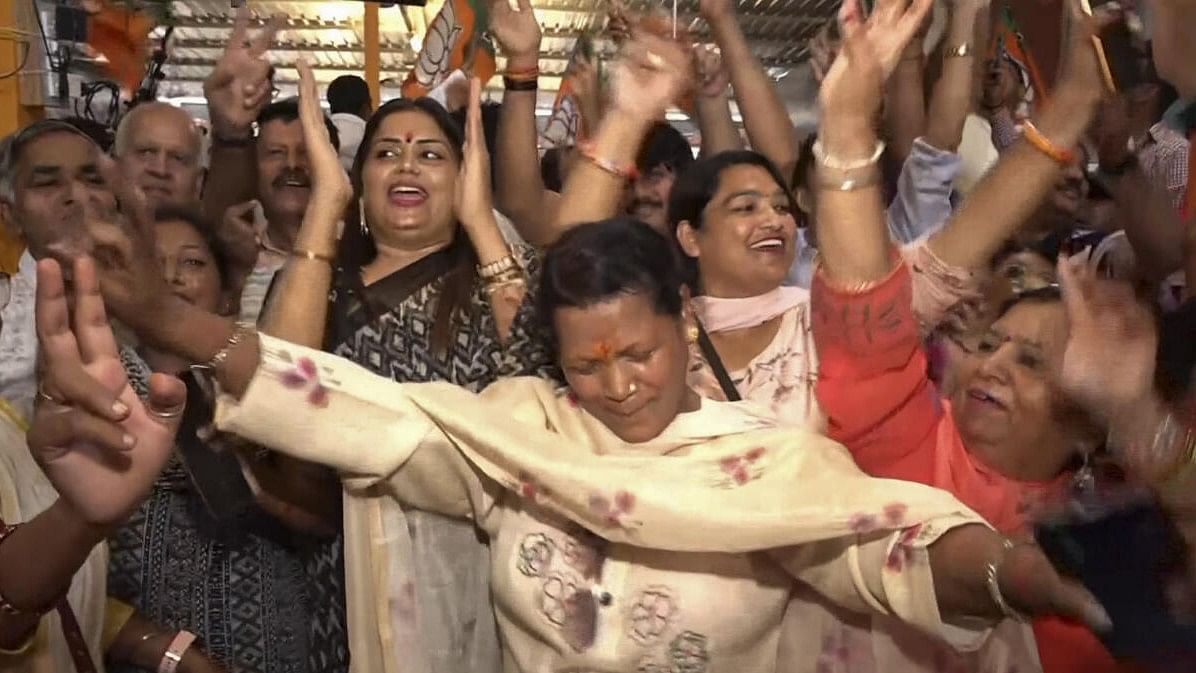
BJP workers celebrate as the party leads during the counting of votes of Haryana Assembly elections, in Ambala district, Haryana, Tuesday, October 8, 2024.
Credit: PTI photo
In a closely contested Haryana election, the Bharatiya Janata Party (BJP) is poised to secure a third consecutive term, marking a significant victory for the party. Early trends initially favoured the Congress, but as the day progressed, the tide shifted, and the BJP gained the upper hand. The election defied exit poll predictions, with the BJP capturing votes from across sections of society.
A crucial factor in this outcome has been the fractured Opposition. The presence of multiple parties, including the Aam Aadmi Party (AAP), JJP, BSP, INLD, and Azad Samaj Party, led to a split in the anti-BJP vote. This division ultimately hurt the Congress, as these smaller parties failed to form a united front.
AAP, in particular, which had engaged in talks with Congress but decided to contest alone, failed to win any seats. However, its presence in urban areas diluted the Congress’ chances in key constituencies, underscoring the importance of strategic alliances in a state where every vote counts.
At this stage, it is evident that the split in Jat-Dalit votes has benefited the BJP, but it’s also crucial to recognise that both the Jats and the Dalits have, to some extent, voted for the party, enabling its significant gains. The Jats make up around 25 per cent of Haryana’s population, while the Dalits account for 21 per cent.
The BJP’s success can largely be attributed to its focused welfare schemes like affordable housing, healthcare, and education, which resonated with both communities, particularly those who directly benefited from these initiatives. The party’s efforts to improve rural infrastructure, roads, and irrigation also won support among Jat farmers.
Additionally, the consolidation of the OBC votes has been a key factor in the BJP’s victory. Previously, under Chief Minister Manohar Lal Khattar, who is Punjabi, there was notable discontent among the Jats. The party responded by appointing Nayab Singh Saini, an OBC, as the chief minister six months before the elections to solidify its OBC base. This strategic move paid off with the OBCs making up about 40 per cent of Haryana’s population.
Moreover, the BJP’s decision to raise the creamy layer ceiling for the OBCs from ₹6 lakh to ₹8 lakh, and introduce a 5 per cent quota for OBC-B in panchayati raj Institutions further cemented its support among the community.
In the current political landscape, the Ahirwal belt — an OBC-dominated region spanning parts of Haryana, Rajasthan, and Delhi — has emerged as a crucial area for the BJP. Recent trends in the 10 seats of the Ahirwal belt — Rewari, Bawal, Kosli, Badshahpur, Pataudi, Ateli, Gurugram, Nangal Chaudhary, Narnaul, and Mahendragarh — show the BJP leading in all except Ateli, where the BSP candidate has a narrow edge.
This success for the BJP can be largely attributed to the fragmented Opposition in a triangular contest. On one side, the Congress battled for dominance, while on the other was split among several smaller political outfits, all targeting the same voter base: the Jats and the Dalits.
Instead of a unified Opposition challenging the BJP’s grip, the fractured vote allowed the ruling party to gain the upper hand.
This election is a clear example of how a divided Opposition can inadvertently strengthen the ruling party’s position, as the BJP capitalised on the disunity among its rivals to maintain dominance in key regions like Ahirwal.
The Haryana election results are an alarm bell for AAP. The party must realise that relying solely on Arvind Kejriwal’s appeal or leveraging emotional narratives around his arrest and the alleged harassment of party leaders by the BJP-led central Union government will not work beyond Delhi. Even in the 2024 Lok Sabha elections, this strategy proved ineffective in Delhi.
While AAP has expanded into Punjab, Goa, and Gujarat, the party must acknowledge that grassroots leadership and credible local faces are essential for success. Without a robust regional organisation and strong, trustworthy leaders in each state, the party cannot expect to win elections beyond Delhi.
Furthermore, AAP must reconsider its approach to alliances. To effectively challenge the BJP in state elections, joining hands with Congress may be crucial. By contesting alone, AAP risks fragmenting the anti-BJP vote, ultimately benefiting the ruling party.
If the party genuinely aims to be a national alternative, strategic coalition-building, alongside a focus on grassroots presence, is the key to achieving sustained political success outside Delhi.
Sayantan Ghosh is a research scholar and teaches journalism at St. Xavier’s College (autonomous), Kolkata. X: @sayantan_gh
Disclaimer: The views expressed here are the authors' own. They do not necessarily reflect the views of DH.
Haryana Assembly poll 2024 results| Check constituency results here
J&K Assembly poll 2024 results| Check constituency results here
Assembly Elections 2024 | In the first assembly polls since the Lok Sabha elections, Narendra Modi and the BJP face a rejuvenated and vindicated Opposition in the Haryana assembly polls. Meanwhile, Jammu and Kashmir is voting after almost a decade and it remains to be seen how the abrogation of Article 370 has impacted the political landscape of the Valley. Check live updates and track the latest coverage, live news, in-depth opinions, and analyses only on Deccan Herald.
Subscribe and follow DH on Whatsapp, X, Facebook, YouTube, and Instagram to never miss out on anything.